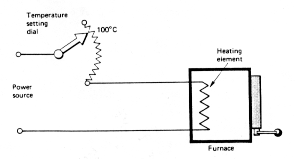Robot Control Systems
Introduction to Automatic control
Automatic control of Robot motion is an essential requirement of any Robotic installation, without it actions would be limited to simple manoeuvres. There are some fundamental factors relating to control systems.
For the purposes of this module a control system may be defined as:
One or more interconnected devices which work together to automatically maintain or
alter the condition of a Robot element in a prescribed manner.
Such a system may be mechanical, electrical, electronic, hydraulic or pneumatic. Most
control systems are combinations of these and are termed hybrid systems.
Open and Closed Loop Control
In theory an input signal is generated in response to a program command, this produces an output signal which activates an
actuator which then moves the Robot element. This is quite a complex process.
One important distinction in control systems is that between open loop and closed loop operation.
eg.
A simple furnace is heated by an electrical heating element controlled by a dial
graduated in degrees C. If a furnace temperature of 100 C is required the dial is set
accordingly. This represents an input command which in turn generates an input signal
(voltage) to the heating element. This input signal produces an output (electric current
and heat) which controls the final temperature. The temperature is called the control
quantity and will stabilise at steady state value, which will be 100 C if the dial has been
calibrated correctly.

On the face of it this is a simple control system for controlling temperature.
However, consider what would happen if the fumace door were left open, the
temperature would drop but the input signal (dial) and the output signal (current)
behave as though they were delivering the requested 100 C. Conversely if a red hot
casting were placed in the fumace the temperature would obviously rise but again the
dial and current would behave as though the correct temperature were being delivered.
In this system the output quantity has no effect on the input quantity this is
called an open loop control system. Care must be exercised when adopting open loop
control as any change in extemal conditions may cause the system to fluctuate in a
manner which cannot be tolerated by the application being undertaken.
Block Diagrams
By convention, control systems are represented by block diagrams
these allow the system to be visualised simply and clearly. eg the block diagram for the
open loop temperature control system.

A thermometer may be added to the system in order to indicate the
temperature of the fumace. The temperature can then be read by a human and the
temperature dial adjusted to increase or decrease the indicated fumace temperature.
This introduces feedback into the system. The output quantity (temperature) is now
having an effect on the input quantity ( only manually ). This system is now called a
"closed loop control system". This is still manual control, it can be made automatic by
replacing the thermometer with a thermocouple. A thermocouple is a device which
produces a voltage proportional to temperature. This voltage is an ideal form of
feedback since it can be easily sensed and read and as there is already a reference
voltage ( the input voltage ) it is possible to compare them. If there is a difference
between them then the actual temperature must differ from the commanded
temperature. This system is said to employ negative feedback.
eg.







